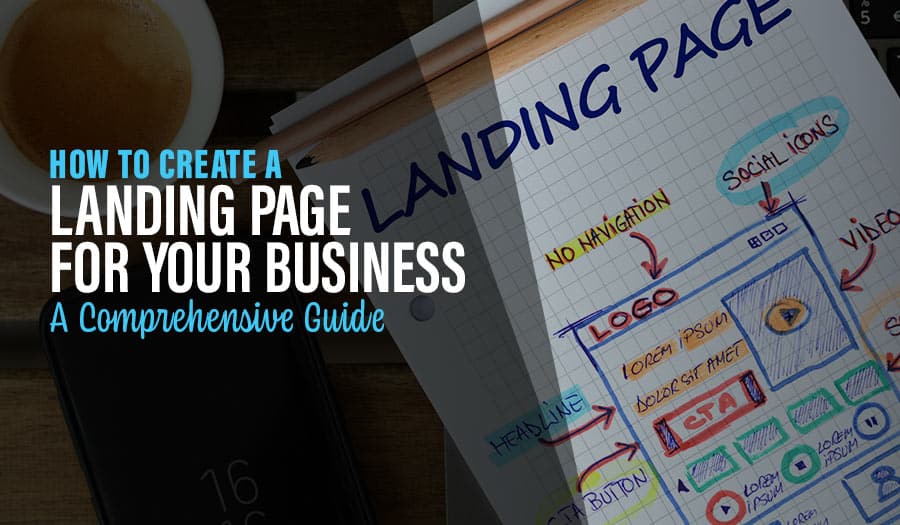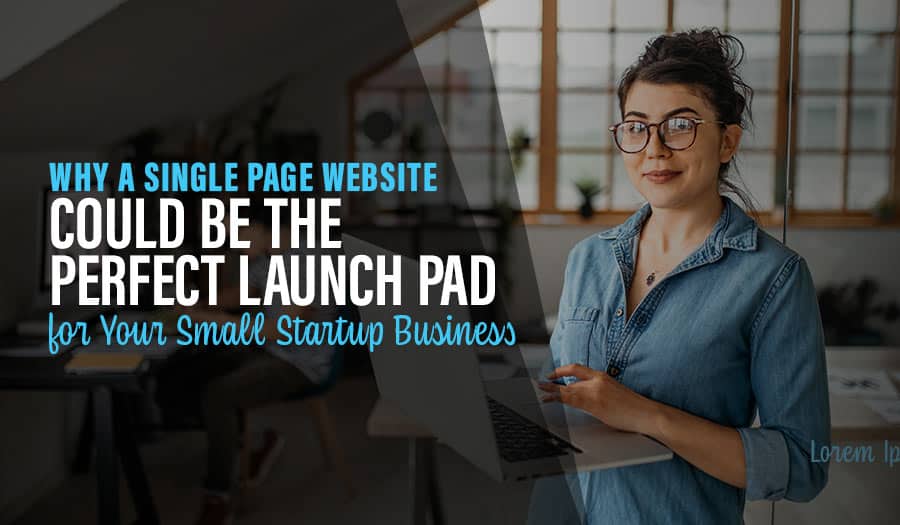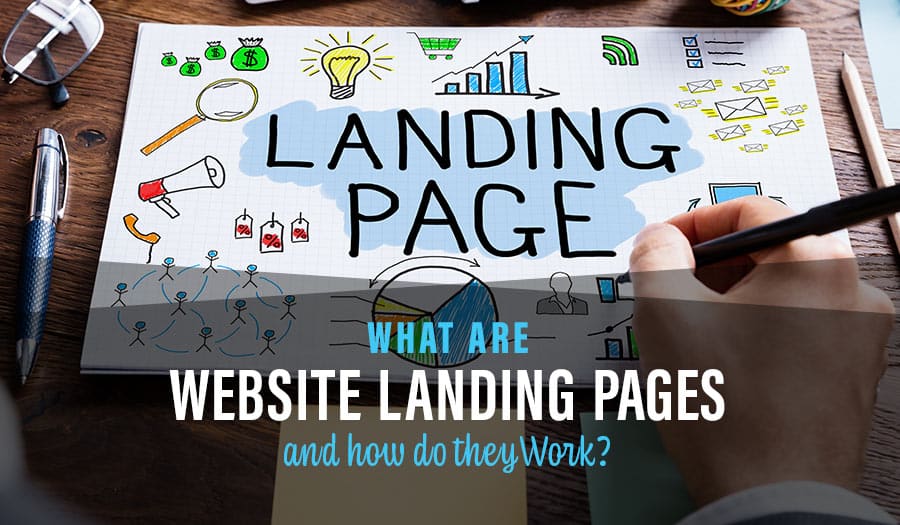The digital marketing landscape, dynamic and ever-changing, has transformed significantly over the past decade. While several strategies, tactics, and tools have emerged, one potent weapon often overlooked by small businesses is the landing page. Let’s explore How to Create a Landing Page for Your Small Business.
Misconstrued by many as merely a destination for your customers after clicking on a hyperlink, a landing page is a critical element of your sales funnel engineered to stimulate conversions, foster customer engagement, and enhance your brand’s digital presence.
This comprehensive guide is designed to demystify creating a landing page, offering actionable steps and best practices to build landing pages and ensure its success.
Creating a Winning Landing Page for Your Small Business
Understanding the Importance of Landing Pages
The first stepping stone in crafting your landing page is comprehending its value and appreciating its role in the grand scheme of your digital marketing strategy. A great landing page, in its essence, is a specialized web page engineered to steer your visitors towards a single action or conversion.
This could range from subscribing to a blog post or a newsletter, downloading an e-book, making a purchase, or any other action you wish your visitors to perform.
Every element of your new landing page, from the headline to the call-to-action (CTA), is crafted to serve this purpose. This makes thnew e landing page a critical component of your online marketing strategy.
A well-optimized landing page can transform a casual browser into a dedicated customer, a prospect into a lead, and a visitor into a patron. This transformative potential underscores the significance of a good landing page, in the online marketing ecosystem.
10 types of landing pages, their uses, and common functions:
- Lead Generation Landing Pages: These landing pages are used to capture user information, such as names and email addresses, which can be used for future marketing initiatives. The most common function of a lead gen landing page is a form visitors fill out in exchange for a freebie or a promise of valuable future content.
- Click-Through Landing Pages: Often used in eCommerce funnels, these pages aim to persuade the visitor to click through to another page (often a product page or a shopping cart page). The main function of a click-through landing page is to educate a prospect about an offer before prompting them to take action.
- Squeeze Pages: A squeeze page is a landing page designed to capture opt-in email addresses from potential subscribers. The goal of a squeeze page is to convince, cajole, or otherwise ”squeeze” a visitor into providing one of their most sought-after pieces of personal data: the email address.
- Sales Pages: These landing pages are focused on one thing – making a sale. They’re often longer than other landing pages and include more information about the product’s features and benefits. The common function of a sales page is to convert a visitor into a customer right on the spot.
- Webinar Registration Pages: These landing pages are used to get sign-ups for an upcoming webinar or online event. The page usually provides details about the webinar content, date and time, and the speakers, aiming to convince the visitor to register.
- Thank You Pages: A thank you page is what most visitors see after they fill out a form on your landing page. Its main function is to acknowledge receipt of the information, but it can also be used to provide next steps, share additional resources, or even make a secondary offer.
- Coming Soon (Pre-Launch) Pages: These pages are used to build anticipation for an upcoming product, service, or a website. They often contain a countdown timer to the launch date and a form to collect email addresses for sending updates or notifications.
- Viral Landing Pages: These landing pages are used to promote a single piece of content with the goal of having it shared widely. Often this content is a valuable resource, an exciting competition, or a compelling story.
- 404 Error Pages: While not traditionally thought of as a great landing page, a 404 error page serves a similar function. It’s where a visitor lands after clicking a broken link or typing a wrong URL. A good 404 page guides the visitor back to the main website, often with links to popular pages or a site map.
- Long-Form Sales Pages: These are like regular sales pages, but they’re typically used for higher-priced items that require more information and persuasion to sell. They include extensive details about the product’s features, benefits, and use cases, as well as social proof in the form of testimonials or case studies.
Each of these landing pages serves a unique purpose, but they all share a common goal: to engage visitors and inspire them to take action.
Step 1: Define Your Goal
The journey of crafting an effective landing page begins with outlining the objective or goal of your new landing page. What do you want your visitors to do when they land on your page? This could be anything from generating leads, selling products or services, collecting user information for future marketing initiatives, or simply fostering engagement with other pages on your brand.
The goal of your landing page is its compass, influencing every aspect of its design, copy, and overall strategy. It informs your headline, guides your content, and shapes your call-to-action (CTA). Therefore, defining a clear, tangible, and attainable goal is an essential first step in the process of crafting your landing page.
Step 2: Know Your Audience
The next step is understanding your target audience. This is a critical component of any any marketing campaign or initiative, and landing pages are no exception. An intimate understanding of your audience informs your content strategy, influences your design, and tailors your messaging to resonate with your audience.
Research your audience’s needs, pain points, and preferences. Understand the language they resonate with, the imagery they respond to, and the incentives they value. Use this information to create content that speaks directly to them, in a language they understand, and with imagery that captivates their attention.
Step 3: Crafting the Perfect Headline
Your headline is the crowning glory of your landing page copy. It’s typically the first thing your visitors will encounter, the first impression, and as such, it should be captivating, relevant, and unequivocal. It should explicitly state what your offer is and do so in a manner that is succinct yet impactful.
A compelling headline hooks your visitor, piques their interest, and motivates them to stay and explore further. Therefore, ensuring that your headline aligns seamlessly with the link that brought your visitor to your page is crucial to ensure consistency and fulfill the promise made to the visitor.
Top tips for creating the perfect landing page headline
- Creating a compelling headline for your landing page is crucial: as it’s often the first thing visitors see and can significantly influence their decision to stay or leave. Here are some top tips for crafting the perfect landing page headline:
- Be Clear and Concise: The most important aspect of a headline is clarity. Make sure your headline clearly communicates what your product or service is and what it does. Keep it short and to the point. If a visitor can’t quickly understand what your landing page is about, they’re likely to leave.
- Focus on the Benefit: Your headline should not just describe your product or service; it should also convey a strong benefit or value proposition. What can visitors get out of what you’re offering? Highlight this in your headline to make it more appealing.
- Use Persuasive Language: The right choice of words can make your headline more persuasive. Power words such as ‘Discover’, ‘Unleash’, ‘Boost’, etc., can evoke emotion and stimulate action.
- Make It Unique: Your headline should differentiate your offering from your competition. Highlight what makes your product or service unique or why your solution is better.
- Target Your Audience: If possible, make your headline specific to your target audience. If your product or service is designed for a specific group, mention them in your headline.
- Create Urgency or Curiosity: Headlines that evoke a sense of urgency or curiosity can be very effective. They can prompt visitors to take action immediately or read on to satisfy their curiosity.
- Test and Optimize: Always test different headline variations to see what resonates best with your audience. Use A/B testing to compare different headlines and select the one that gets the best response.
Remember, your landing page headline plays a critical role in drawing visitors in and convincing them to stay on your page. It’s worth spending the time to craft a clear, persuasive, and compelling headline.
Step 4: Persuasive Copy
The body copy of your landing page is the meat of your content. It should be persuasive, relevant, and underscore the benefits that your product or service provides to your audience. The goal of your body copy most landing pages is to persuade your visitors that your offer will provide them with tangible benefits and solve a problem they are facing.
Therefore, it’s crucial to utilize simple, digestible language to remove industry-specific jargon that could alienate or confuse your visitors. Use bullet points to underscore key benefits, and craft your content so it can be skimmed easily, accommodating the browsing habits of most web users.
Quick tips for creating persuasive website copy
Understand Your Audience: One of the most crucial steps in writing persuasive website copy is understanding who you’re writing for. Research your target audience’s needs, preferences, and pain points. Using this information, tailor your message to resonate with them and address their specific needs or problems.
- Focus on Benefits, Not Features: While features are important, they don’t necessarily sell your product or service. Instead, focus on the benefits. How does your product or service improve your customers’ lives? How does it solve a problem they’re facing? Your audience wants to know what’s in it for them, so make sure your copy answers this question clearly and convincingly.
- Create a Strong Value Proposition: Your value proposition is a clear statement that explains how your product solves customers’ problems, delivers specific benefits, and why you’re better than the competition. It’s the primary reason a prospect should buy from you. Your value proposition needs to be the first thing visitors see on your home page, but it should be echoed on every page.
- Use Clear and Concise Language: Avoid jargon, complicated words, or long sentences. Your copy should be easy to read and understand. Break up your text with subheadings, bullet points, and images to make it skimmable. Keep your language simple, straightforward, and focused on the customer.
- Include a Call-to-Action (CTA): Every piece of website copy should have a purpose; most of the time, that purpose is to motivate the reader to take action. Whether it’s to “Buy Now”, “Sign Up”, or “Contact Us”, make sure your CTA is clear, compelling, and easy to locate. Use action words to create a sense of urgency and provide a compelling reason why the visitor should take the desired action immediately.
Writing persuasive website copy is an art. It requires a deep understanding of your audience, a focus on benefits rather than features, and the ability to communicate your value proposition clearly and compellingly. By following these tips, you can create website copy that engages your audience and drives them to take action.
Step 5: Showcasing Social Proof
Social proof is a powerful, persuasive tool in the digital marketing toolbox. It refers to testimonials, reviews, case studies, and any other content that demonstrates the value and effectiveness of your offer. By showcasing social proof on your landing page, you bolster its credibility and sway your visitors’ decision-making process in your favour.
Opt for genuine testimonials that highlight the unique benefits of your offer. Sharing success stories from satisfied customers, notable endorsements, or case studies that demonstrate the effectiveness of your product or service can work wonders in establishing trust and motivating conversions.
This sense of legitimacy is often best cultivated through the integration of social proof. Customers today are savvy, and they look for evidence of the effectiveness of your products or services before they convert. Demonstrating this social proof – the psychological phenomenon where people follow the actions of others under the assumption that those actions are indicative of the correct behaviour – on your landing page can considerably enhance its credibility.
This can be in the form of customer testimonials, reviews, case studies, or endorsements, each lending a voice of authenticity to your offering. Opt for genuine testimonials that highlight the unique benefits of your product or service. Sharing success stories from satisfied customers or notable endorsements can establish trust. This trust is a vital factor in the customer decision-making process, helping to eliminate doubt, build confidence, and inspire action.
Step 6: High-Quality Visuals
The well-worn adage, “A picture is worth a thousand words,” holds especially true in the realm of landing pages. High-quality, pertinent images stock photos or videos can significantly bolster your landing page copy and vividly demonstrate your product or service in action. Humans are inherently visual creatures and are more likely to remember and engage with information that is presented visually. Utilizing compelling visuals can, therefore, make your landing page more memorable and influential.
However, while visuals are important, they must be optimized for quick loading. Internet users today are impatient, and slow-loading elements can quickly deter potential customers, leading them to abandon your page. Additionally, page load speed is a factor that search engines consider when ranking pages in search engines, meaning that slow-loading elements can potentially harm your search engine ranking. It’s a delicate balance between creating an aesthetically pleasing page with high-quality visuals and ensuring those visuals load efficiently.
Step 7: The Essential Call-to-Action (CTA)
The CTA is arguably the most critical component of your landing page. This button or link serves as the final push, prompting your visitors to take action. A good CTA should stand out from the rest of the landing page content, guiding visitors clearly towards your desired action. Keep the language compelling, concise, and action-oriented, such as ‘Download Now’, ‘Get Started’, or ‘Sign Up’.
But it’s not just the language that matters – the positioning of your CTA also plays a vital role. It should be prominently displayed, easily noticeable, and should appear multiple times if your landing page is long. Color contrast, size, and whitespace around the image block the CTA button can also influence its visibility and effectiveness.
3 great examples of compelling website calls to action (CTAs):
Netflix: The streaming giant’s landing page is clean and clutter-free, with a compelling CTA: “TRY 30 DAYS FREE.” What makes this CTA stand out is the use of the word “try,” which suggests a low-commitment, risk-free experience. This is reinforced by the “cancel anytime” reminder, making the action of signing up feel even safer for potential customers.
Dropbox: Dropbox does an excellent job with their simple and direct CTA on their landing page. The button says, “Try Dropbox Business free,” which is straightforward and to the point. But what makes it more effective is the secondary text above it that reads, “Get started with a 30-day free trial.” This text makes it clear to the visitor what they should expect after clicking the button, eliminating any ambiguity and reducing anxiety about what comes next.
Evernote: Evernote’s landing page features the CTA, “Sign up for free.” It’s a simple, no-nonsense approach that speaks directly to new users. The CTA is accompanied by the secondary headline “Remember Everything,” which ties back to the product’s value proposition. By clicking the CTA, visitors are led to believe they’ll gain the ability to remember everything – a powerful incentive indeed.
In all these examples, the CTAs are clear, action-oriented, and tied to a specific benefit or value the user will receive, which is a key aspect of effective call-to-action design.
Step 8: Streamlining Form Fields
If your landing page strategy includes a form, keeping it simple and non-intimidating is crucial. The number of fields you request directly influences your conversion rate – the more fields you include, the lower your conversion rate is likely to be. Ask only for the information you absolutely need. Make it clear what the user will receive in return for filling out the form, and reassure them that their information will be kept secure and confidential. Trust is vital in this exchange, and maintaining transparency about the use of customer information can help build this trust.
Step 9: Mobile Optimization
With a growing number of users accessing the internet via mobile devices, ensuring your landing page is mobile-friendly is essential. A mobile-optimized landing page will afford a superior user experience, leading to higher conversion rates. This entails crafting responsive designs that render correctly on different screen sizes, ensuring text is readable, images load correctly, and interactive elements like buttons and forms are easy to navigate.
Step 10: Testing and Analytics
Lastly, never assume that your landing page is perfect from the get-go. The digital marketing landscape is a dynamic one, and constant testing, analyzing, and adjusting is the key to staying relevant and effective.
A/B testing different elements such as headlines, images, and CTAs can help you understand what resonates best with your audience. Employ analytics tools to track your landing page’s performance, using this data to make informed decisions about further optimizations. Remember, improvement is a continuous process, and a successful landing page is one that evolves with its audience.
Benefits of creating Landing Page Templates
Creating a landing page template is an efficient strategy for rolling out multiple campaigns, especially for businesses that consistently create unlimited landing pages to launch new products, services, or other marketing campaigns and initiatives. With a well-designed template, you can maintain brand consistency, streamline the creation process, and achieve better results across all your campaigns.
The advantage of using a landing page template is that it serves as a starting point, with a predetermined layout, style, and format that aligns with your brand. This saves considerable time and resources that would have been spent designing each landing page from scratch. You can effortlessly duplicate the template and tweak the content, visuals, and other elements to match the specific requirements of each campaign.
Moreover, creating create a landing page template gives you an opportunity to incorporate effective design principles and elements that have proven successful in the past. If certain features of your best landing page builder or pages have shown to improve conversions – such as the placement of your CTA, the form design, or the use of testimonials – these can be included in your template to ensure their use in all future landing page builders and pages.
Finally, using how to create a landing page template can facilitate easier A/B testing. By maintaining a consistent structure across your landing pages, you can more accurately determine the effectiveness of different headlines, copy, images, and other elements in driving conversions.
In conclusion, a landing page template can greatly enhance the efficiency and effectiveness of rolling out multiple campaigns. By ensuring brand consistency, facilitating the design process, and allowing for optimal use of proven design elements, unlimited and free landing page templates and pages templates can become a valuable asset in your digital marketing toolkit.
While creating a landing page may seem intimidating at first, by adhering to these landing pages best practices below, small businesses and marketing managers can produce compelling landing pages that drive conversions and help achieve business objectives. Always remember, an effective landing page is more than just a visually pleasing web page. It’s a strategic marketing tool, that, when utilized effectively, can significantly bolster your online marketing efforts. Happy landing page creation!
What are the common traits of high converting landing pages?
- Relevant messaging: Make sure the words on your page are relevant to what you are advertising or offering, and that the information you provide is factually accurate.
- Engaging design: Design your landing page with an eye-catching aesthetic that will draw in visitors. Keep the layout simple and organized for easy reading and navigation.
- Strong calls-to-action: Include a clear and concise call-to-action to encourage visitors to take the desired action. Ensure that it stands out from the rest of the page and is visible above the fold.
- Trust signals: Gain visitor trust by including social proof such as customer reviews, testimonials, and logos of recognizable companies you work with.
Get started today on building the professional website your small business needs!
Take your business to the next level with a Pixel Fish Website.
Check out some of our latest Website Design projects.
View some case studies of our website design work:
Blackwood Advisory
CBK Waterproofing
Priority Advisory Group
Davidsons Plumbing
Further Information
Why you should use Elementor for your new WordPress Website
What are Landing Pages, and how do they Work?
Top Landing Page Design Mistakes to Avoid at all Costs
Key Features of Successful Landing Page Creation
10 Tips for Creating Landing Pages
Landing Page Design: Understanding the various Types of Landing Pages
Elementor Page Builder: A Comprehensive Guide for Business
Responsive Web Design: Why It Matters and How to Implement It
An Introduction to Website Design for Small Business
How Professional Custom Web Design can help your business stand out online
Understanding WooCommerce Website Development for Ecommerce Success
Get the Best Custom Website Design Solution for Your Business
Exploring the Benefits of the Divi Theme for WordPress
Comprehensive Guide to Ecommerce Web Design
Why Displaying Social Media Reviews On Your Website Is Great For Business



